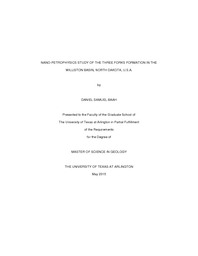
ATTENTION: The works hosted here are being migrated to a new repository that will consolidate resources, improve discoverability, and better show UTA's research impact on the global community. We will update authors as the migration progresses. Please see MavMatrix for more information.
Show simple item record
| dc.contributor.author | Baah, Daniel Samuel | en_US |
| dc.date.accessioned | 2015-07-31T22:10:08Z | |
| dc.date.available | 2015-07-31T22:10:08Z | |
| dc.date.submitted | January 2015 | en_US |
| dc.identifier.other | DISS-13090 | en_US |
| dc.identifier.uri | http://hdl.handle.net/10106/25052 | |
| dc.description.abstract | The Late Devonian Three Forks Formation has increasingly become one of the productive plays in the Williston Basin, North Dakota. This growth has been attributed not only to new drilling and completion techniques but also to the availability of new geological information. Although production in the Three Forks Formation has increased, maximum recovery and overall hydrocarbon production is still limited. According to the North Dakota Industrial Commission, the oil recovery factor in the Three Forks Formation is 8.9±5.32%, so only a small percentage of the original oil in place is being produced.One of the most challenging aspects of reservoir quality in the Three Forks Formation has been characterizing the permeability, porosity and tortuosity which affect fluid flow and chemical transport in tight rocks. These parameters are macroscopic manifestation of the pore geometry and topology which are not easily accessible because of the dominant nanometer-scale pores. More information is needed with regards to the nanopore size distribution and how the pore connectivity is related to fracture networks.The mixed siltstone/sandstone/carbonate samples for all of five members of the Three Forks Formation were obtained from well Round Prairie 1-17H from Williams County (API No. 18257). For these tight rocks, we have studied the pore structure, edge-accessible porosity, and wettability using the following complementary tests: mercury intrusion capillary pressure, tracer imbibition and tracer diffusion into fluid-saturated rock. The latter was done by pulling a vacuum on dry rock followed by the introduction of a tracer-free fluid. These tests use tracer-bearing fluids (API brine or n-decane) to examine the association of tracers with mineral or kerogen phases, followed by elemental analyses with laser ablation-ICP-MS to map out the presence and distribution of tracers inside the rock. The results from these innovative approaches indicate the limited accessibility and connectivity of nanopores in the samples. In addition, the Three Forks Formation seems to be mostly oil-wetting, with fast imbibition and diffusion for n-decane tracers. The interplay of wettability and connectivity could lead to the steep first-year production decline and low recovery factors because of the limited pore connectivity which inhibits the migration of hydrocarbon molecules in the rock matrix to the stimulated fracture network. | en_US |
| dc.description.sponsorship | Hu, Max | en_US |
| dc.language.iso | en | en_US |
| dc.publisher | Environmental & Earth Science | en_US |
| dc.title | Nano-petrophysics Study Of The Three Forks Formation In The Williston Basin, North Dakota, U.S.A. | en_US |
| dc.type | M.S. | en_US |
| dc.contributor.committeeChair | Hu, Max | en_US |
| dc.degree.department | Environmental & Earth Science | en_US |
| dc.degree.discipline | Environmental & Earth Science | en_US |
| dc.degree.grantor | University of Texas at Arlington | en_US |
| dc.degree.level | masters | en_US |
| dc.degree.name | M.S. | en_US |
Files in this item
- Name:
- Baah_uta_2502M_13090.pdf
- Size:
- 3.974Mb
- Format:
- PDF
This item appears in the following Collection(s)
Show simple item record


